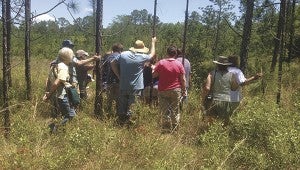Arboretum Paths: Take a closer look at our state’s late spring bloomers
Published 7:00 am Wednesday, May 28, 2014

LATE BLOOMERS: Participants in a recent field walk to the Arboretum’s Hillside Bog stop to listen to Heather Sullivan describe a plant specimen.
Photo by Pat Drackett
Lately, our Savanna Exhibit has been reminding me of one of those pattern puzzles, the kind that instruct you to stare at for a long time and then all of a sudden, some hidden shape will jump out, having been there all along. This is the same experience one goes through when hunting orchids in the Savanna. With so many other plants mixed together, it can take a very long time and several people pointing their fingers, and then, there it is! Once you see one bloom, your eyes begin to recognize the pattern, and soon you will be spotting more.
Orchid species like those currently blooming here are unusual and exquisite. Hopefully, they will only serve to awe you with their beauty rather than inspire attempts to possess them. Our goal at the Crosby Arboretum is to encourage visitors to learn how to recognize and appreciate Mississippi native plants, including rare and magnificent wildflowers. Many of these species are quite difficult to transplant and to cultivate, but here at our public garden you can observe them growing in their native habitats.
Would you like to press some plant specimens? We have several plant presses that can be checked out for on-site use if you will call ahead. Leave your specimens here to dry for a few days, and come back later to pick them up. We don’t mind groups who wish to collect specimens for educational purposes, for example, a class leaf collection project, however, we ask that when removing material it is done carefully. This means “clipped, not ripped”. Please let us know in the office when you arrive that you wish to collect that day.
When collecting native plants, use common sense and don’t pull up a plant up by its roots, instead, clip with scissors or pruners and cleanly remove the blooms or parts you need. Because we use prescribed fire as a management tool, all of our grasslands are burned periodically, so you will not be harming the plants if you will be clipping a few specimens. Obviously, if you see many of the same species blooming, removing a few will not have a significant impact. But please don’t pick a bloom or collect a plant if you only see a few of them occurring.
Like native orchids, our orange fewflower milkweed (Asclepias lanceolata) is one of these “stand-alone” species. Only a few are found now in our bog, but this monarch butterfly host plant is easy to pick out in a crowd. I sometimes imagine how this milkweed must appear to a butterfly gliding over the savanna, honing in on that one brilliant orange flower cluster that waves about, on the end of a slender stem that towers above the grasses and other blooms.
Heather Sullivan, state botanist and curator of the herbarium at the Mississippi Museum of Natural Science, and Marc Pastorek of Meadowmakers, led us on a field walk to our Hillside Bog natural area on Saturday. Heather manages the data base for the Mississippi Natural Heritage program, and keeps records – and monitors – plant species of concern in the State.
It is not unusual during a field walk to see her pull out her phone and record a GPS coordinate for “new special plant occurrences”. On our Saturday walk, Heather recorded a population of the small Coastal Plain spreading pogonia orchid (Cleistesiopsis oricamporum, aka Cleistes bifaria) a species classified as rare (S-3) in Mississippi (less than 70 populations in the state).
This orchid is scattered throughout our Savanna Exhibit, and also found in other Arboretum natural areas. It may be more abundant in our coastal counties than recorded. Learn to identify Mississippi’s rare plants, and “hunt” them with your camera, not your clippers. Perhaps you will report a population that ends up on our State Heritage Map.
Take an entertaining and informative botany walk at the Arboretum with Dr. Mac Alford, Herbarium Curator and Associate Professor at USM, Hattiesburg. He is also an expert on our native grasses, and able to answer all of your plant questions with ease. Call the Arboretum office at (601) 799-2311 to sign up for this program. For more information, visit www.crosbyarboretum.msstate.edu. The Arboretum is open Wednesday through Sunday from 9 a.m. to 5 p.m. and is located in Picayune, off I-59, Exit 4, at 370 Ridge Road (south of Walmart and adjacent to I-59).
FOR FURTHER EXPLORATION: Search for lists of plants and animals that are considered rare or endangered in the state of Mississippi, and learn to identify them in case you come across them in your travels.



